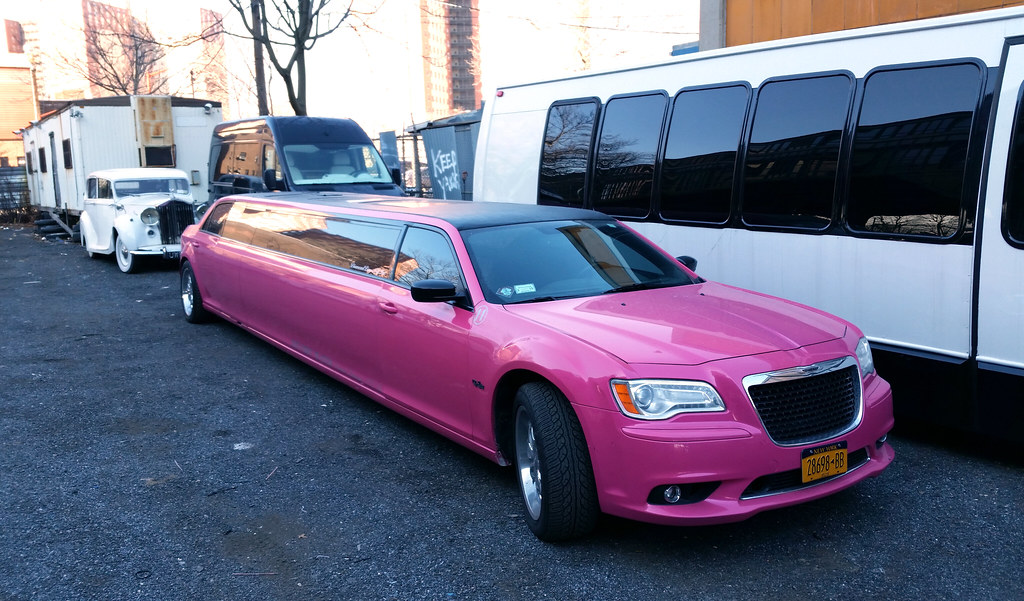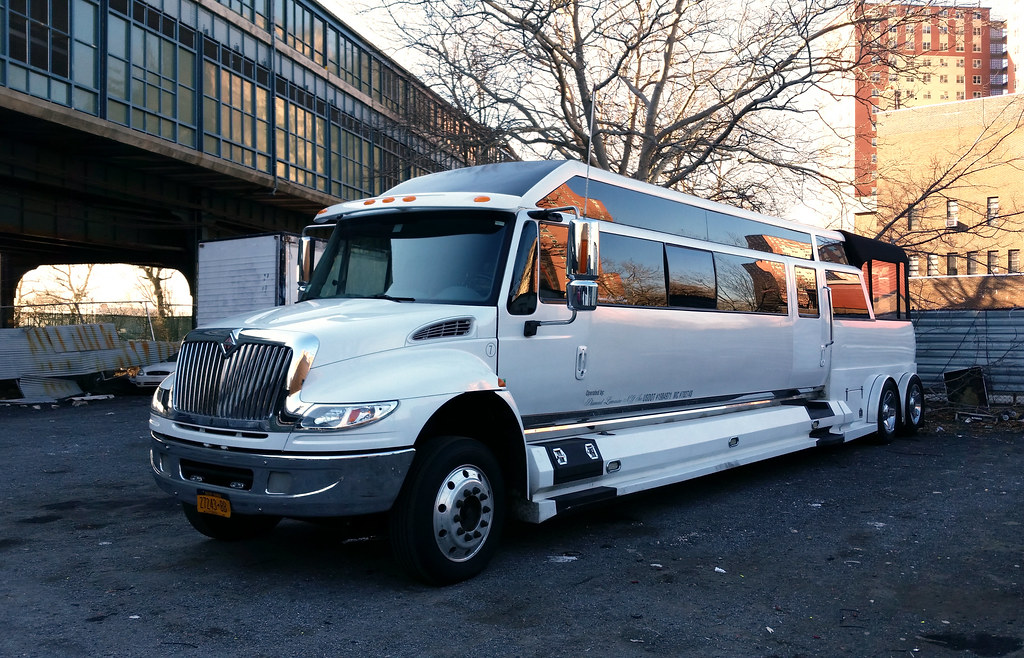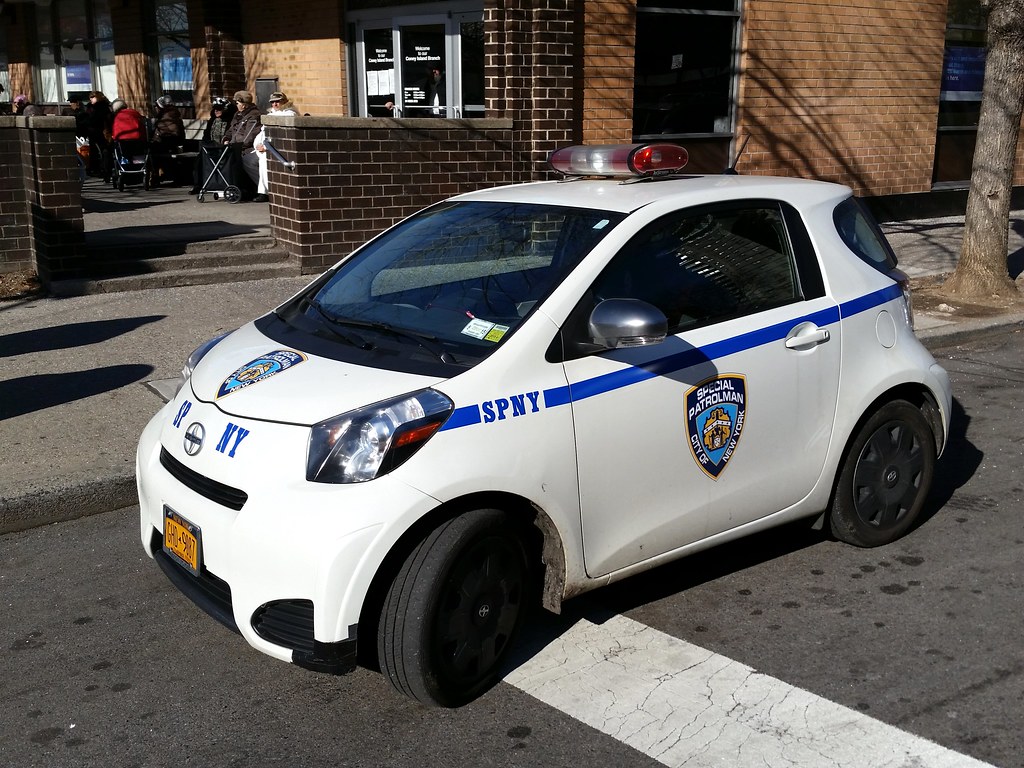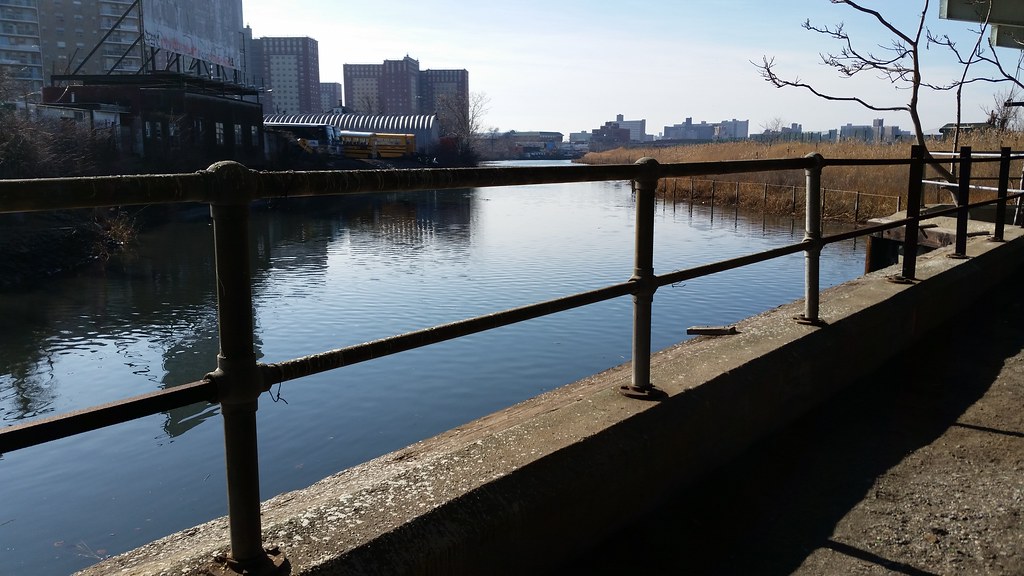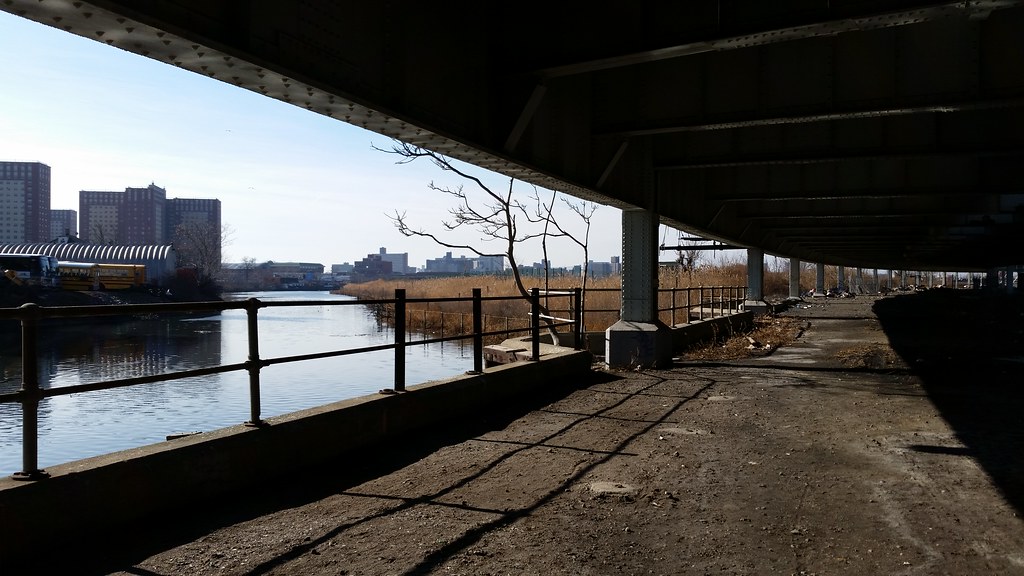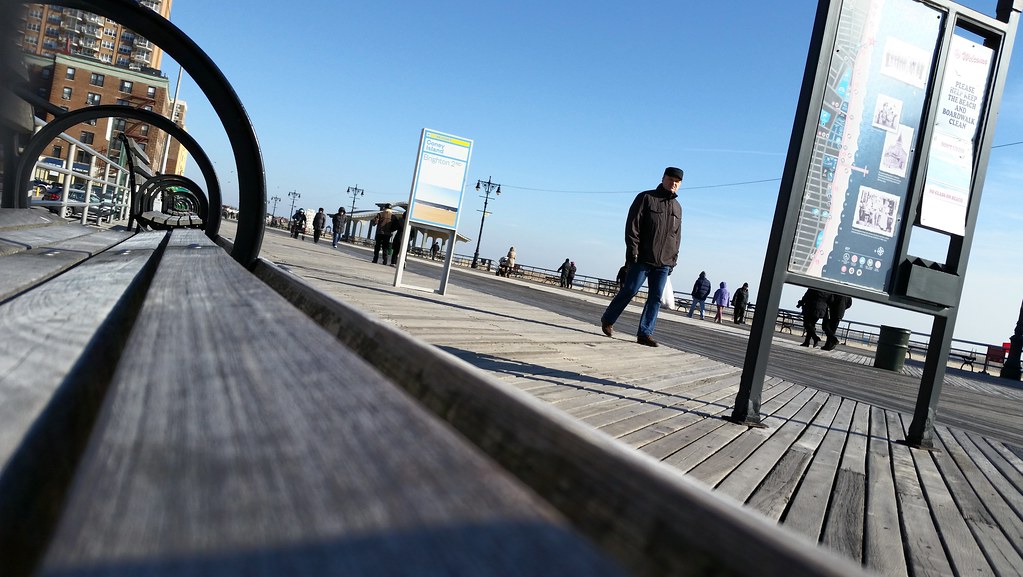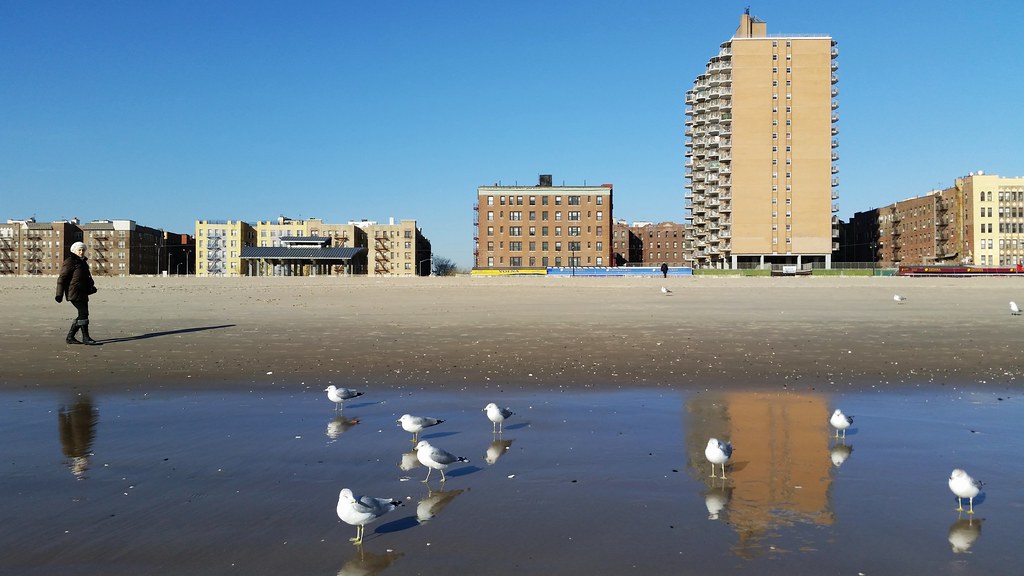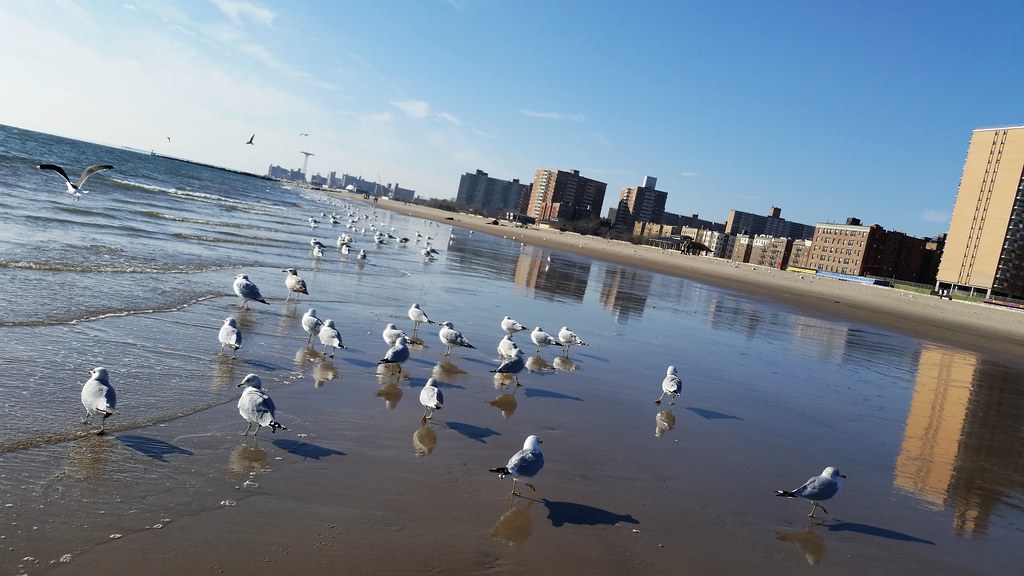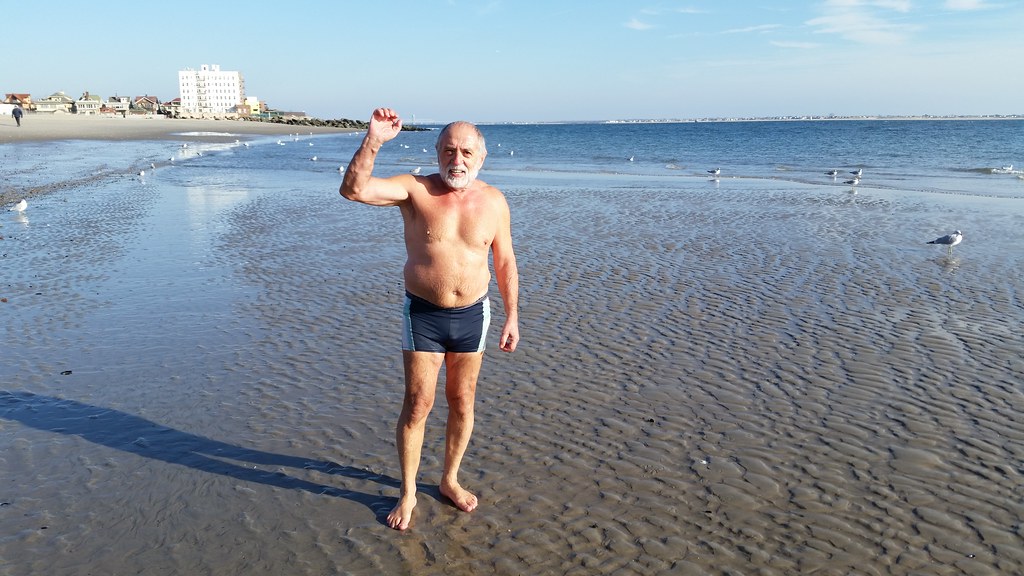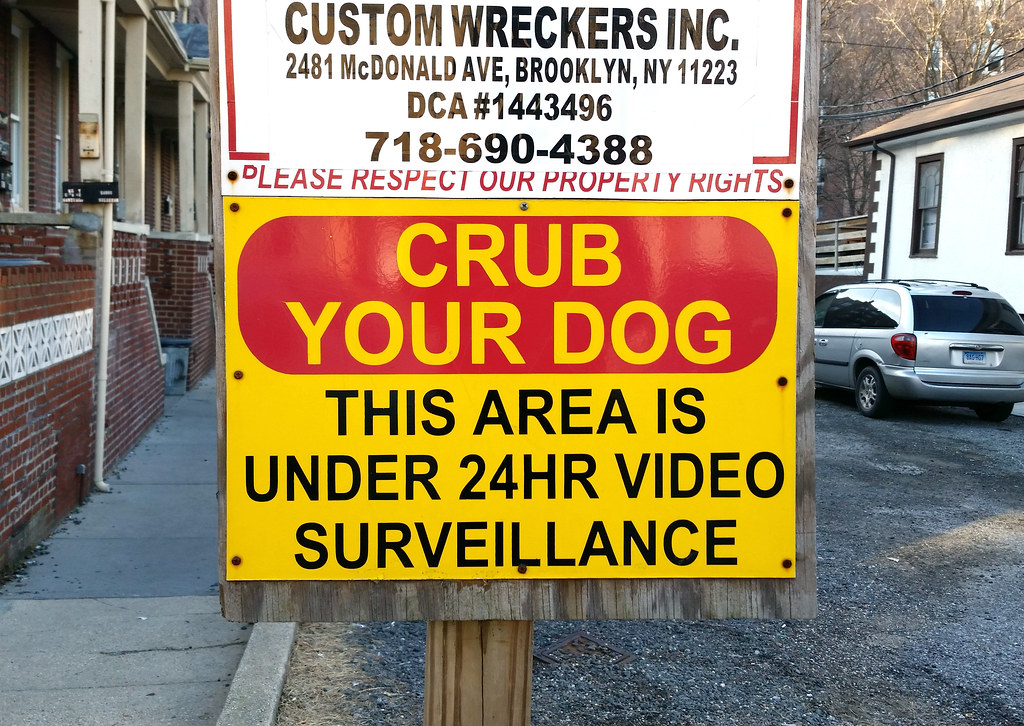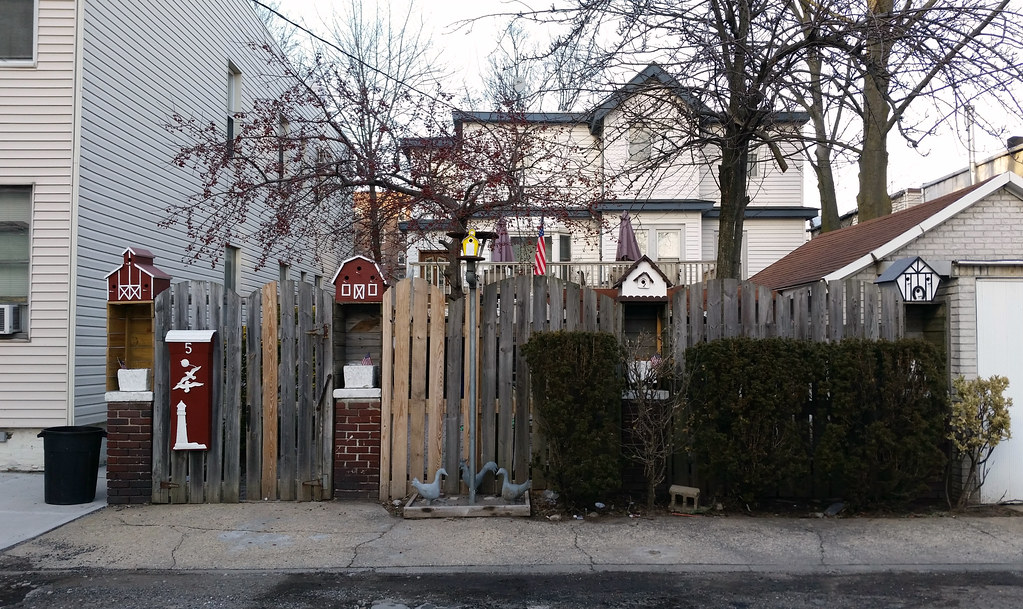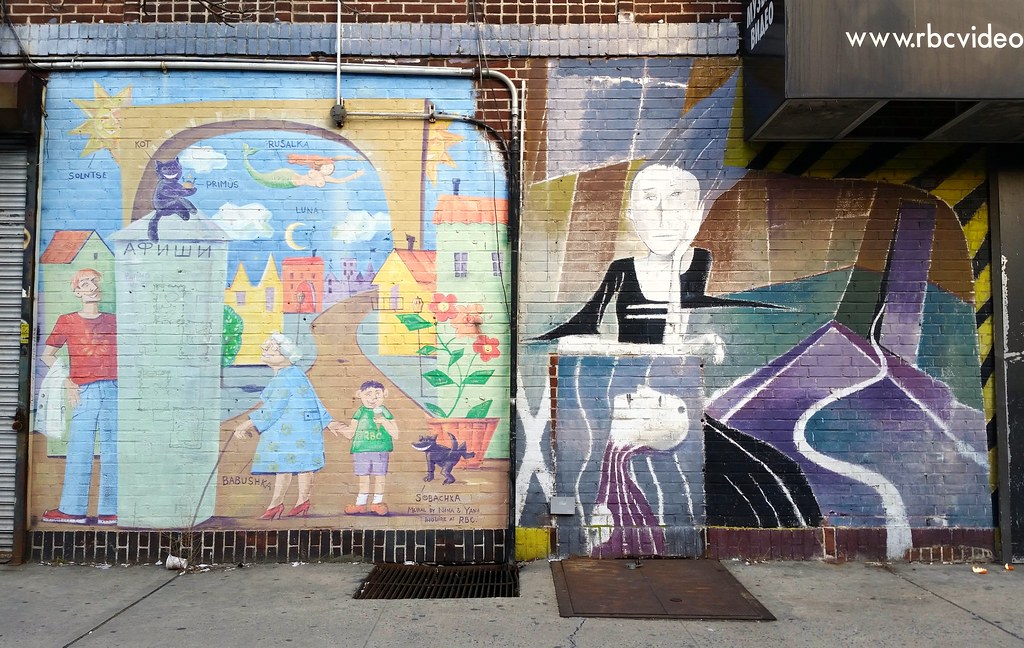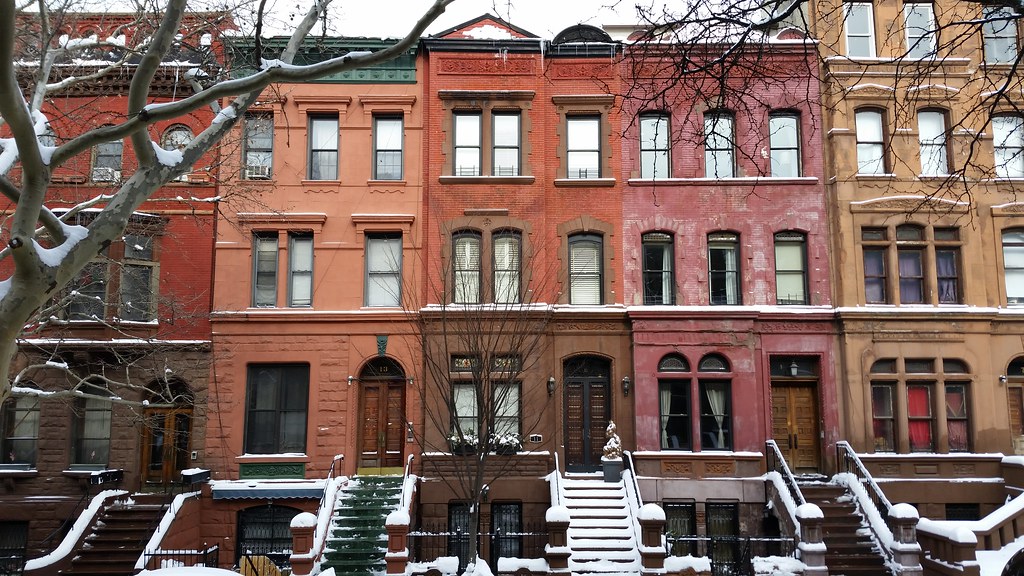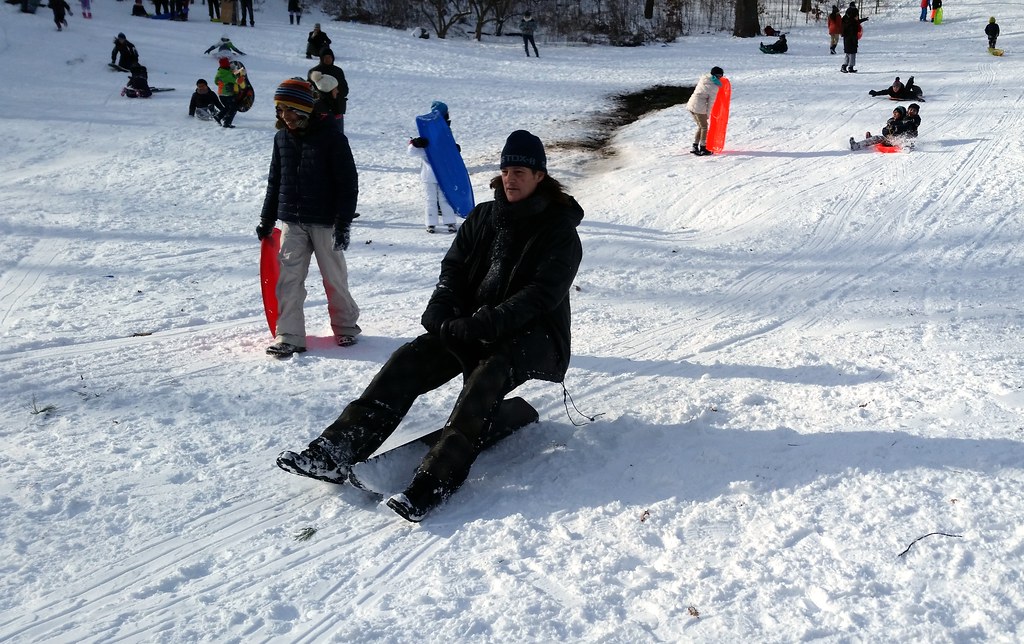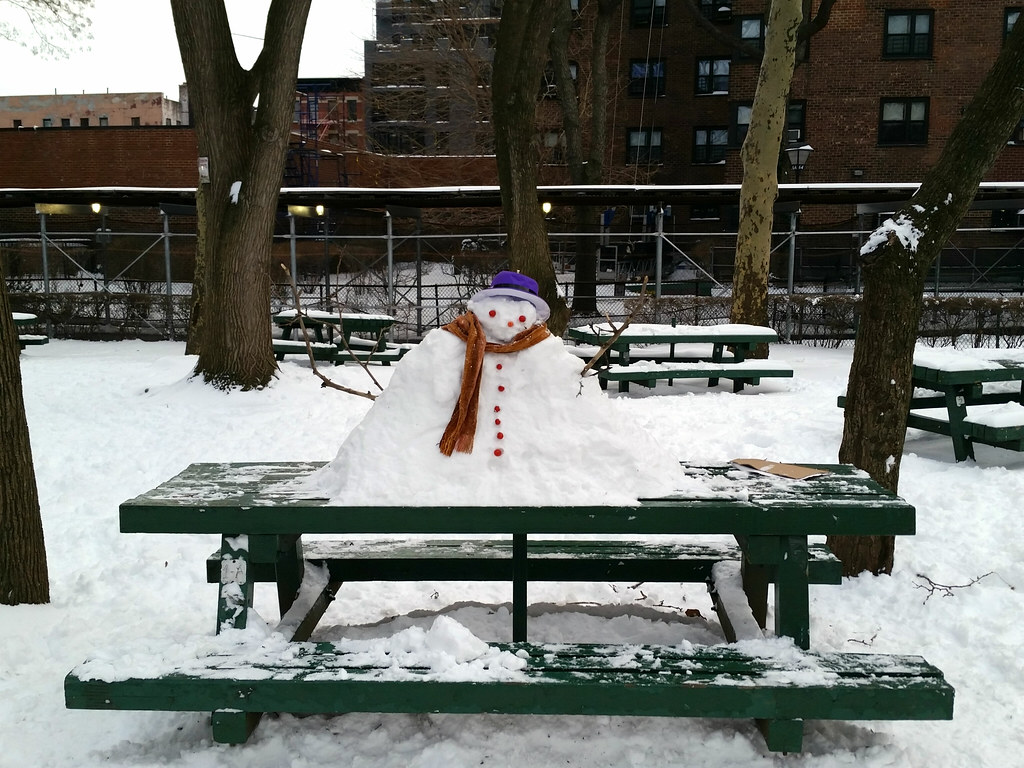
The modern-day incarnation (map) of a Coney Island classic
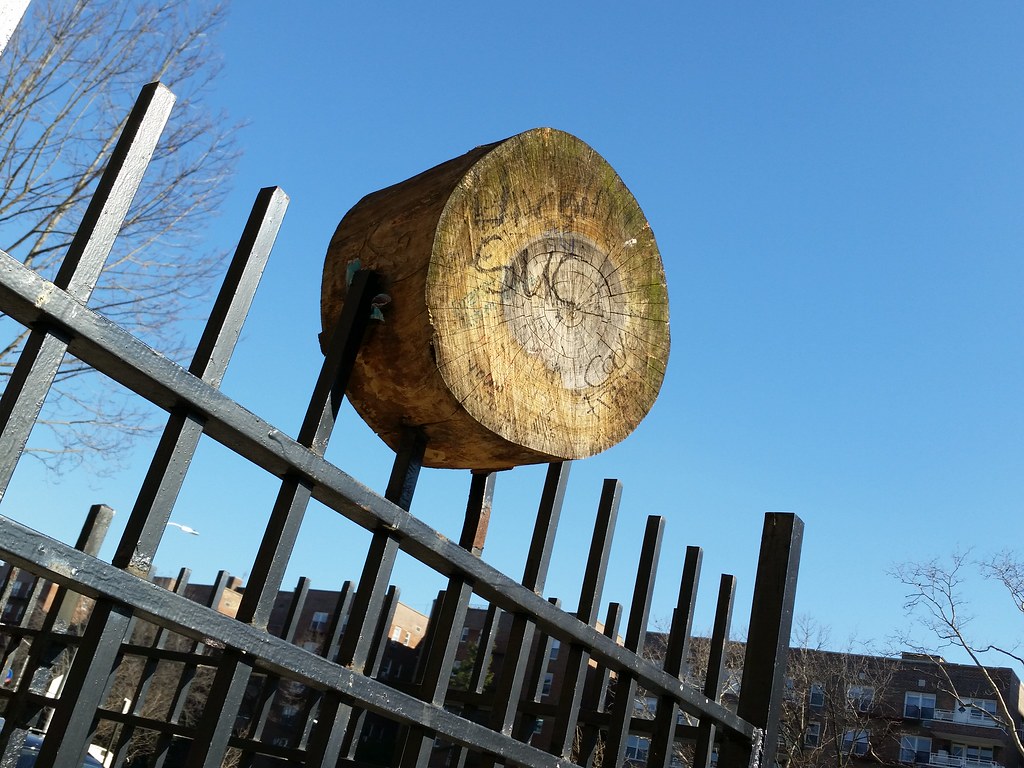
Using Street View, you can see that this log appeared here on the fence surrounding Lincoln High School sometime between June 2012 and September 2013. In that same interval, a sidewalk tree near the fence came down. Perhaps Hurricane Sandy brought the tree down onto the fence, and perhaps a little section of the tree was left on display as a reminder of the devastation wreaked by the storm. Sandy not only damaged the basement and the football field here at Lincoln; it also forced several students out of their homes and took the life of one of the school's teachers.
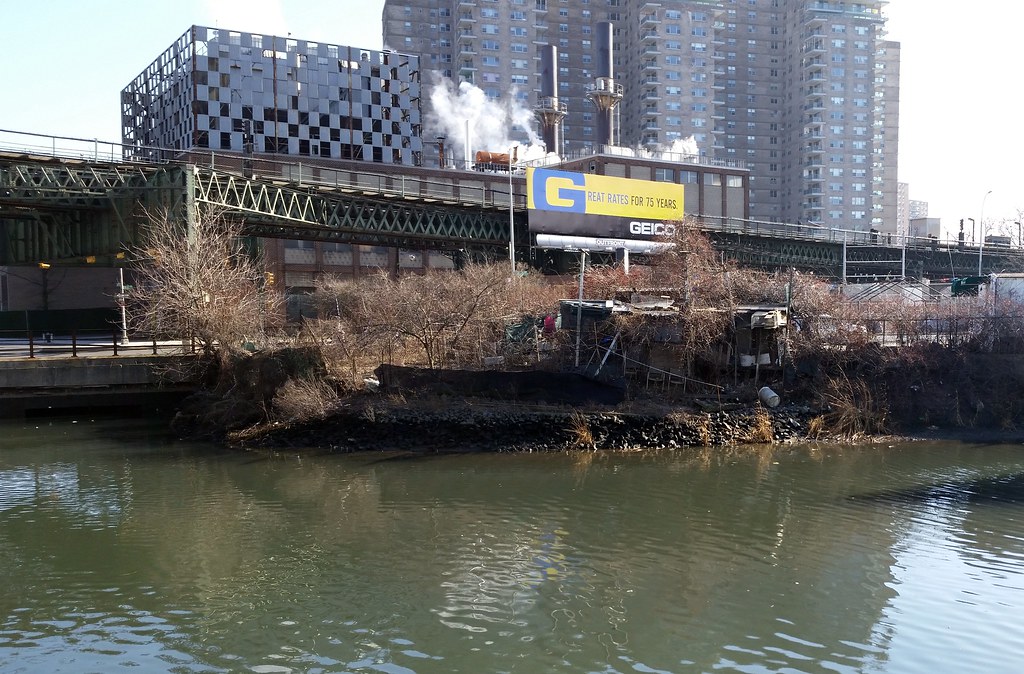
Nearly invisible from the adjacent street, a ramshackle structure can be seen across Coney Island Creek standing on a small, fenced-off parcel of Parks Department land. If you look closely, you can see a pair of chairs and what appear to be a couple of bird cages; a 2011 Street View image shows some birds (presumably pigeons) roosting on the roof.
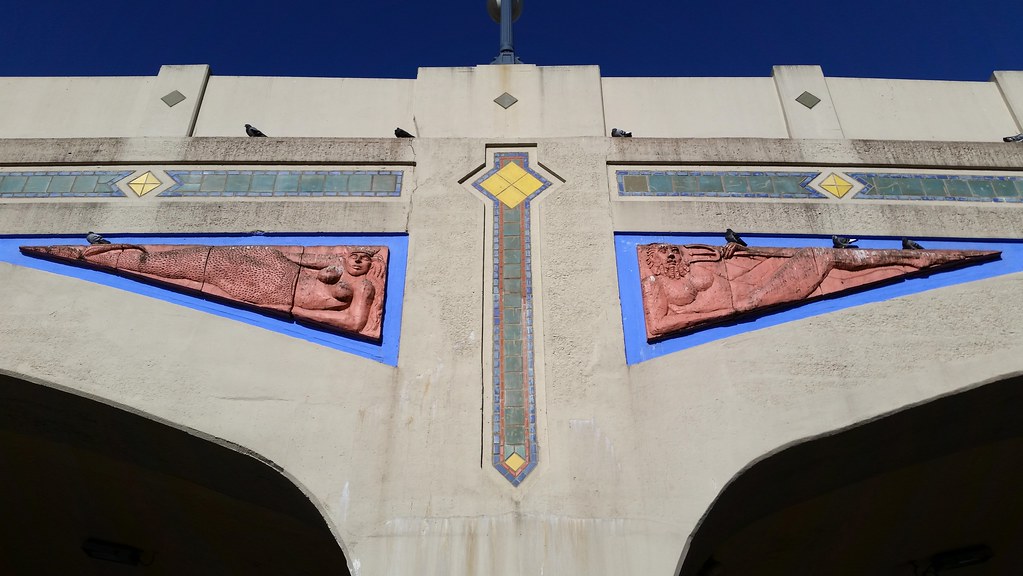
A mermaid and the sea god Neptune (along with several pigeons) can be found sunbathing on the side of the subway viaduct at the Ocean Parkway Q train station. These panels are part of Deborah Masters's Coney Island Reliefs, an art installation almost 20 years in the making.
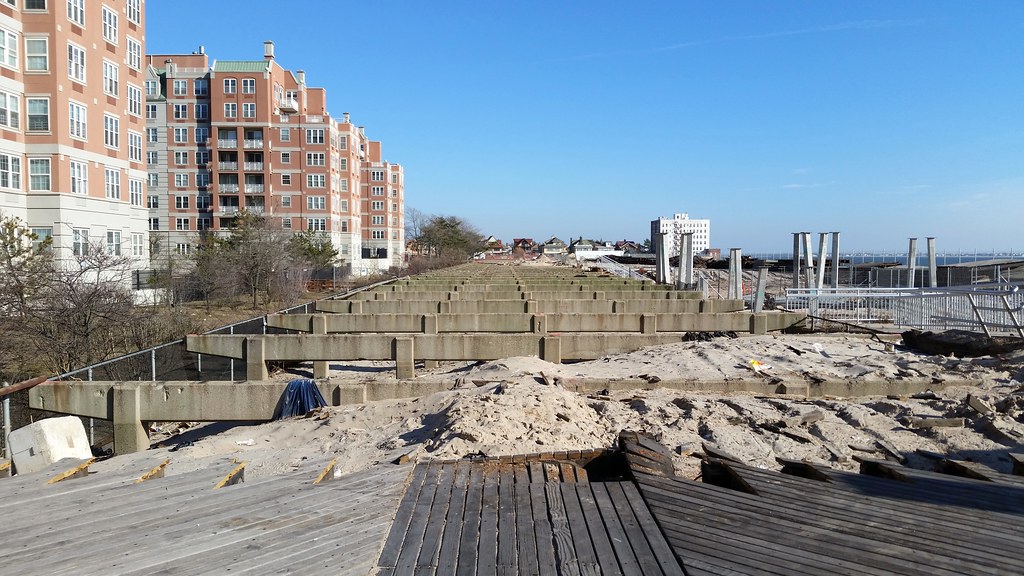
Much to the dismay of some locals, this section of the Coney Island Boardwalk between Brighton 15th Street and Coney Island Avenue is being replaced with a surface of recycled plastic boards and concrete.
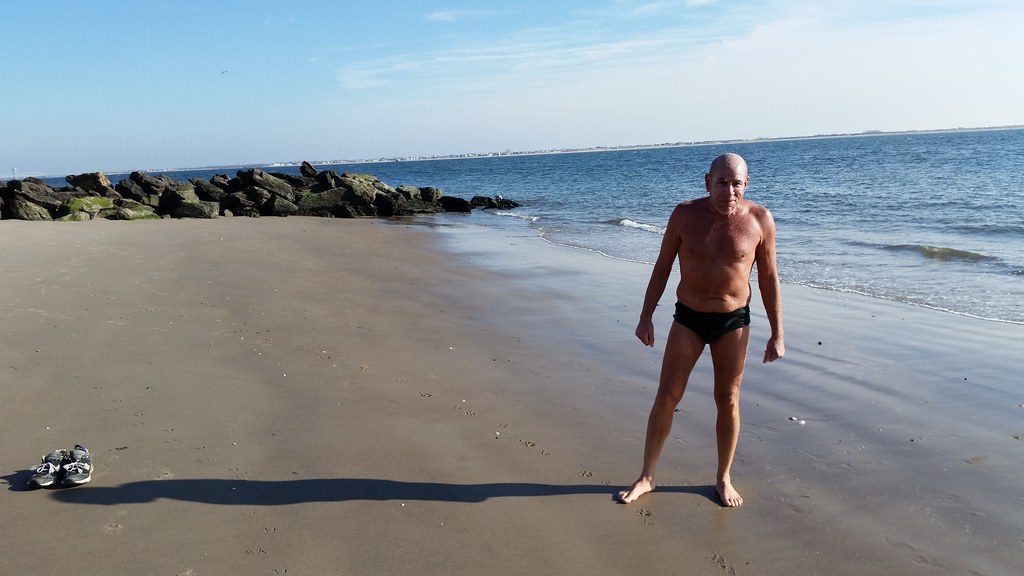
As I was walking down the shore of Brighton Beach on a chilly, sub-40-degree January afternoon, I saw this gentleman emerge from a plunge in the Atlantic. His name is Gary, he lives nearby, and he says jumping in the ocean is a daily ritual for him.
(Gary is standing less than 100 yards from here.)
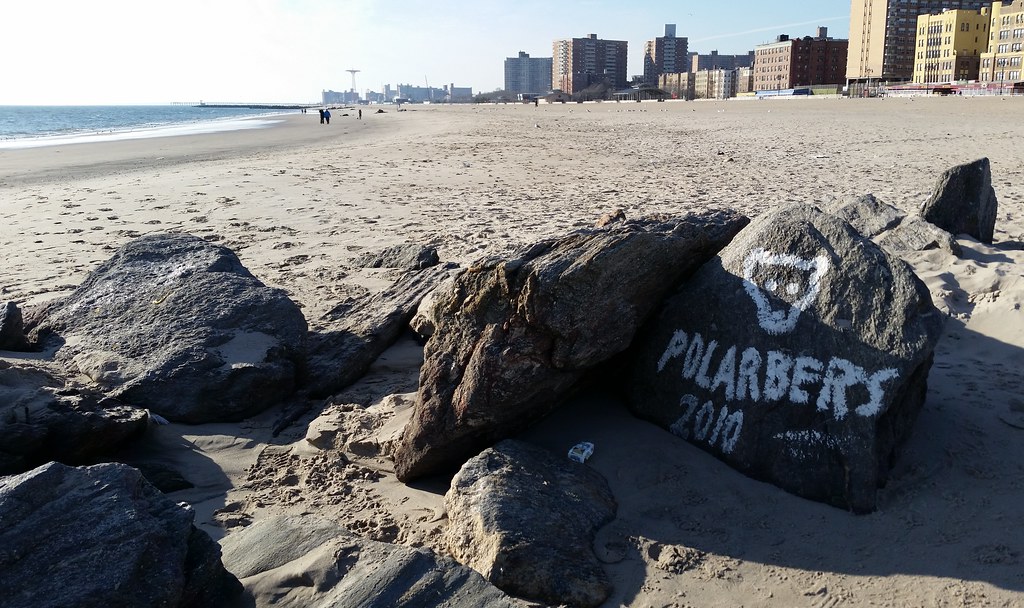
Gary and Felix make these once-a-week sissies look pretty silly.
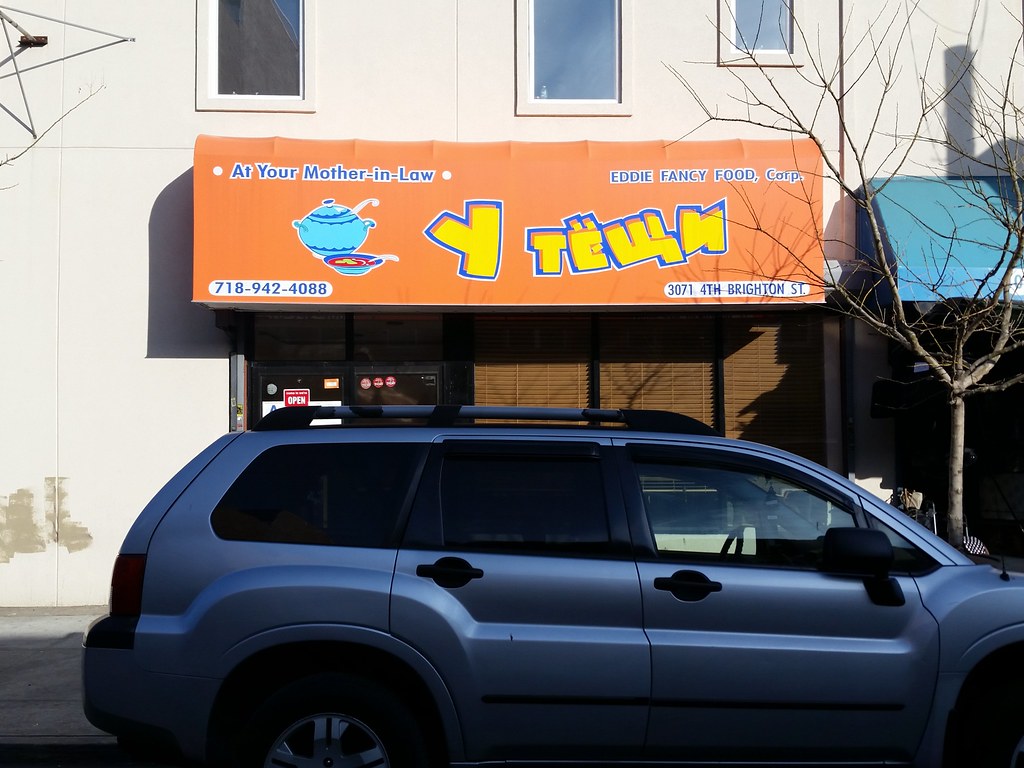
A Russian-Uzbek-Korean cafe. You can thank Joseph Stalin for this seemingly unlikely culinary combination: in 1937, he forcibly relocated some 170,000 ethnic Koreans from the Russian Far East to Soviet Central Asia.
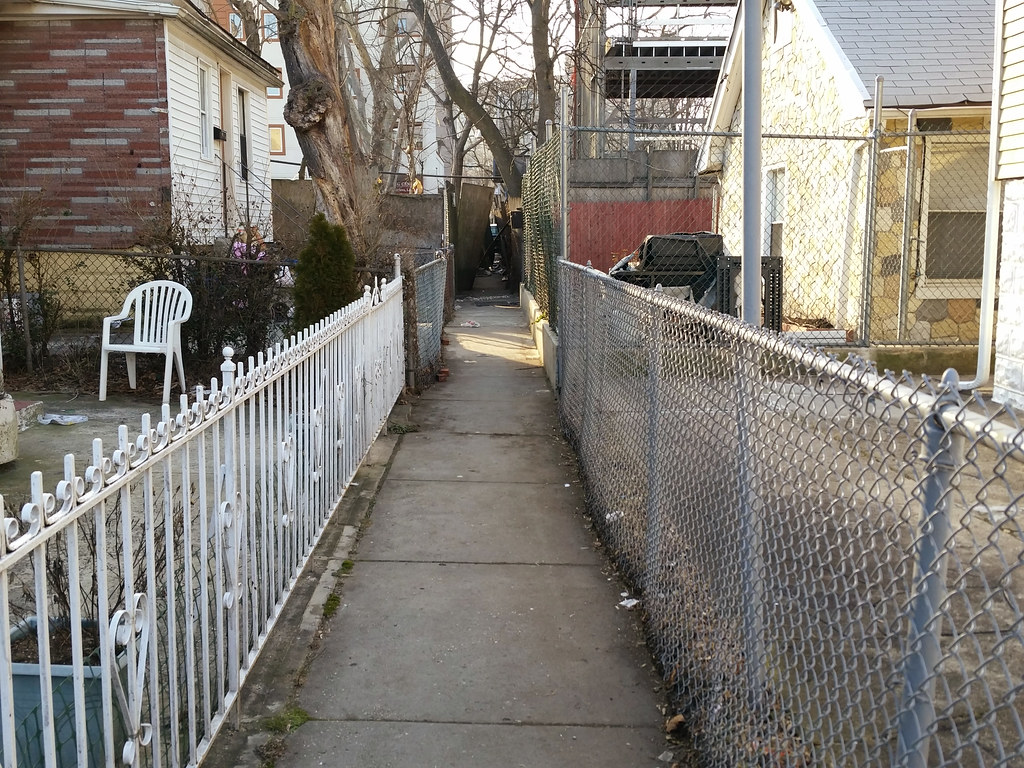
This is one of the many narrow pedestrian alleys (map) crisscrossing Brighton Beach's dying bungalow district, which has been heavily scarred by haphazard development over the past 15 years or so. (Note, for example, the skeleton of the multi-story building-to-be in the background at right. That project, which required the demolition of three houses, has been stalled since at least June 2012. And in the background at left, you can see a shoddily constructed plywood fence, part of which is toppling onto the walkway. That fence surrounds three lots acquired almost a decade ago by a developer who leveled the houses that stood there by 2009 and has left the land sitting vacant ever since.)

This HVACR academy at William E. Grady High School was dedicated on July 17, 2002, the 100th anniversary of Willis Carrier submitting his design for the first modern air-conditioning system, which was installed in a Brooklyn printing plant. According to the NY Daily News, the dedication ceremony here at the school featured a 400-pound ice sculpture of the inventor.
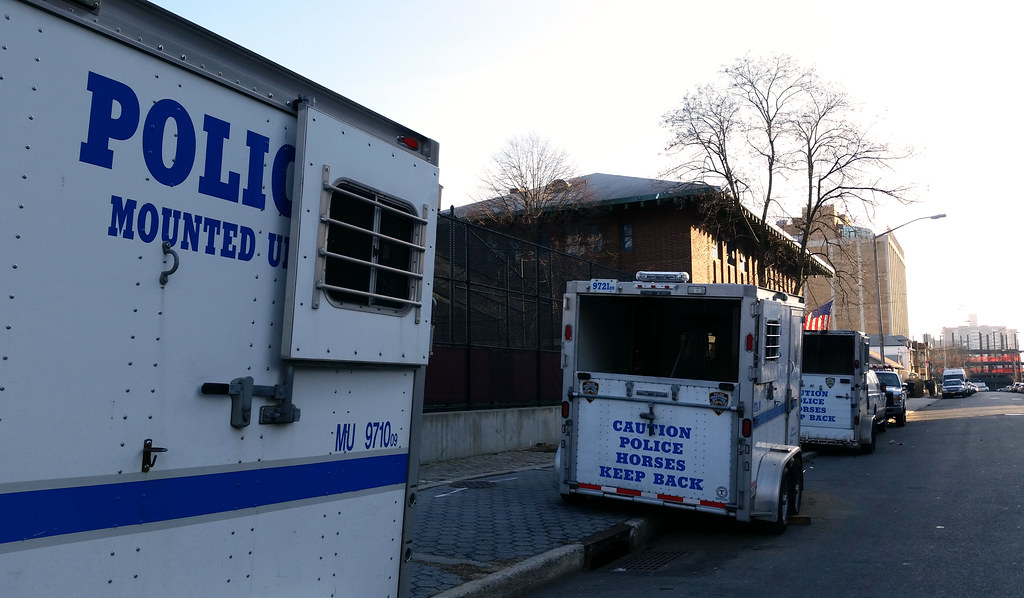
These trailers are parked outside the NYPD's mounted unit Troop E stable. Check out this Street View image of the stable building. The horses are apparently kept on the second floor. Note the (poop?) chute coming out of the second floor and emptying into a dumpster.
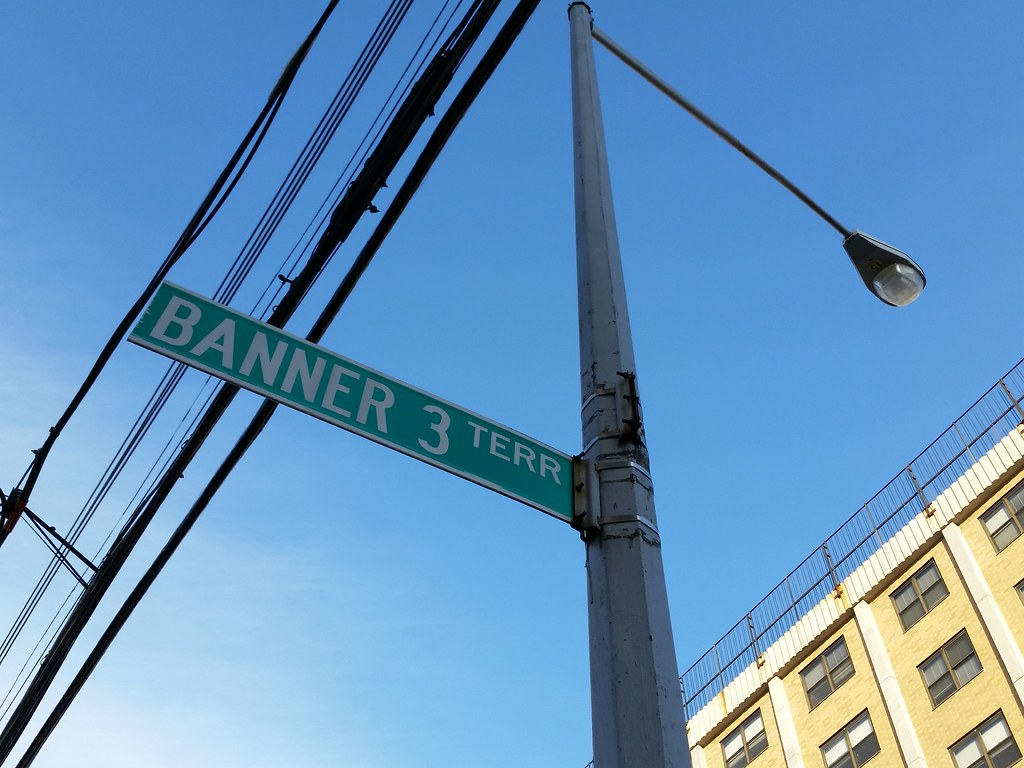
Banner is the most obscure of all the Brooklyn street prefixes. Before discovering it today, I would have bestowed that title upon Plumb: there are only three numbered Plumb roadways — Plumb 1st through 3rd Streets — comprising several blocks altogether. But the Banner prefix is even rarer. It exists only in the names of two short dead-end streets: Banner 3rd Road and Banner 3rd Terrace.
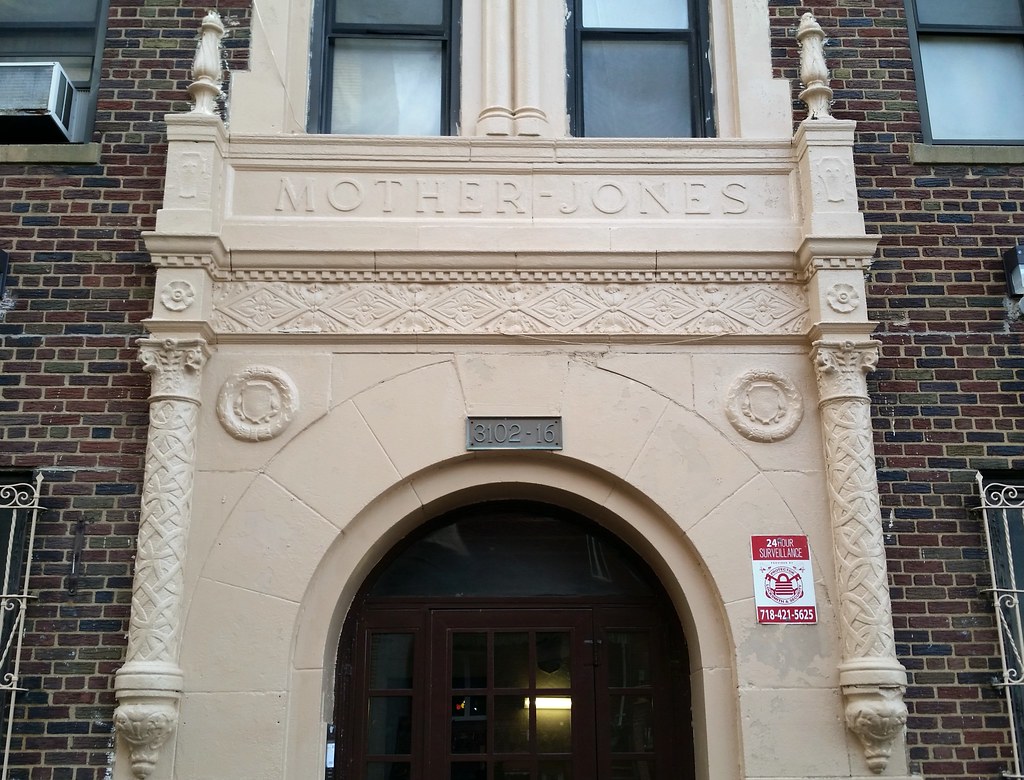
According to the NY Times, this circa-1935 building was one of several apartment houses in Brighton Beach named after socialist leaders. Mary Harris "Mother" Jones, eponym of Mother Jones magazine, was a "fiery union organizer" and a co-founder of the Industrial Workers of the World.
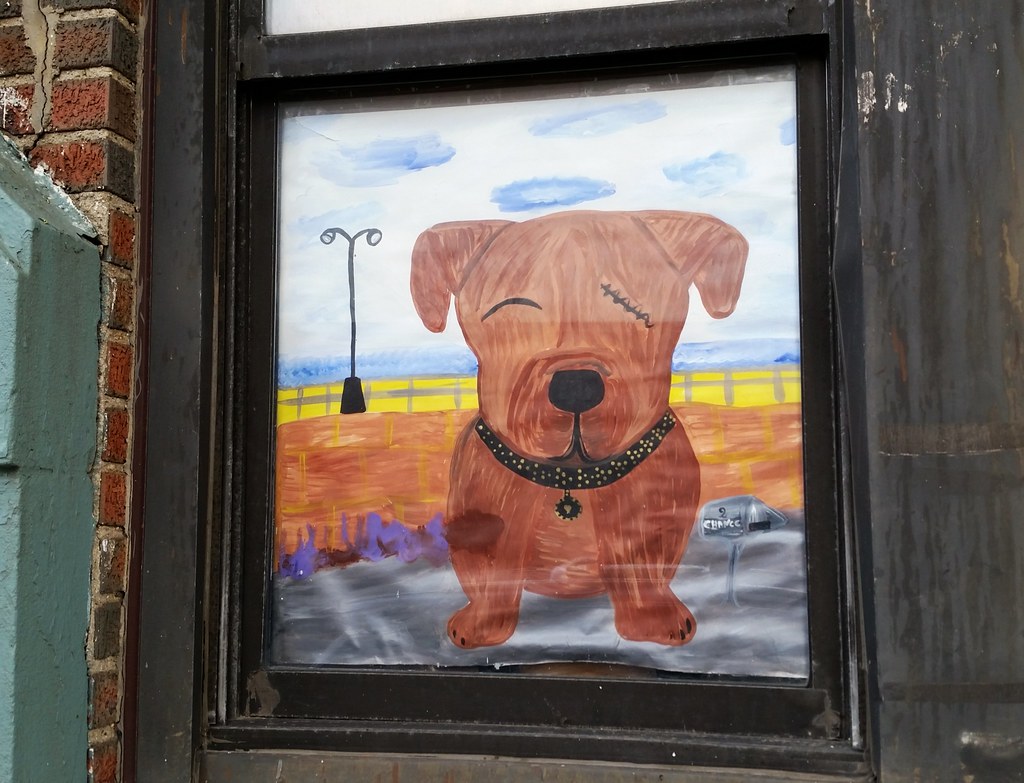
This portrait is part of a window-mounted canine art gallery in someone's first-floor Brighton Beach apartment.
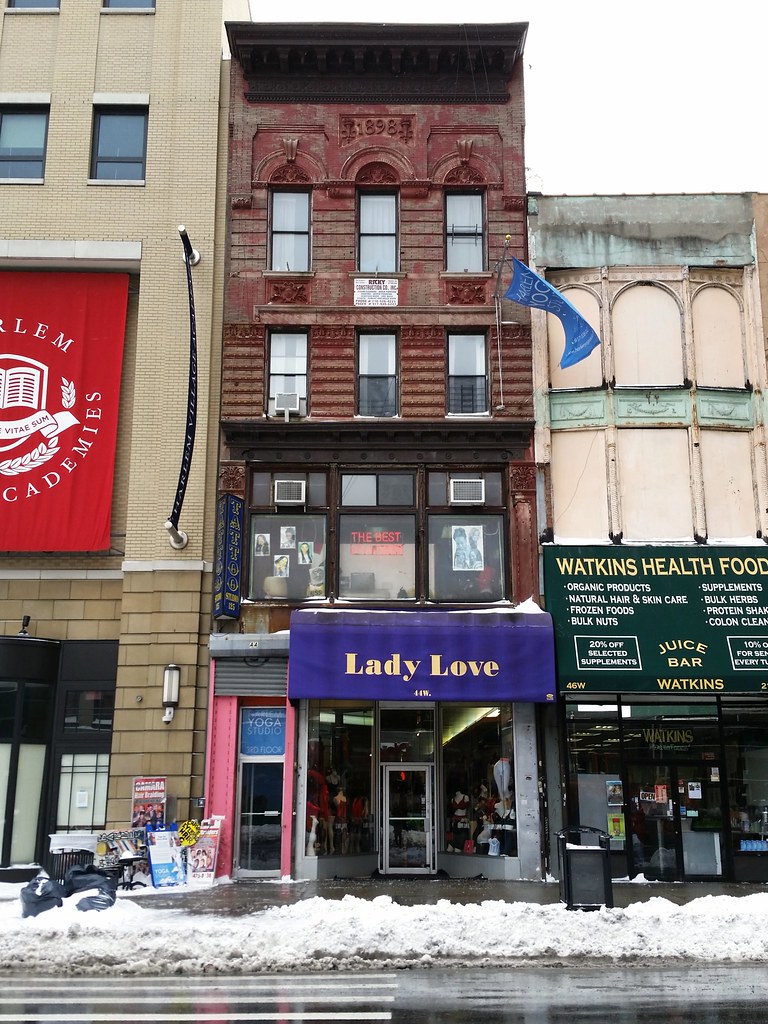
This is the relatively unimpressive aftermath of Winter Storm Juno, the "blizzard that wasn't" (in the city, at least). The predictions of the storm's fury were so dire — The Onion's headline was "NYC Mayor: 'Reconcile Yourselves With Your God, For All Will Perish In The Tempest' " — that, for the first time ever, the subway system was shut down because of (anticipated) snow.
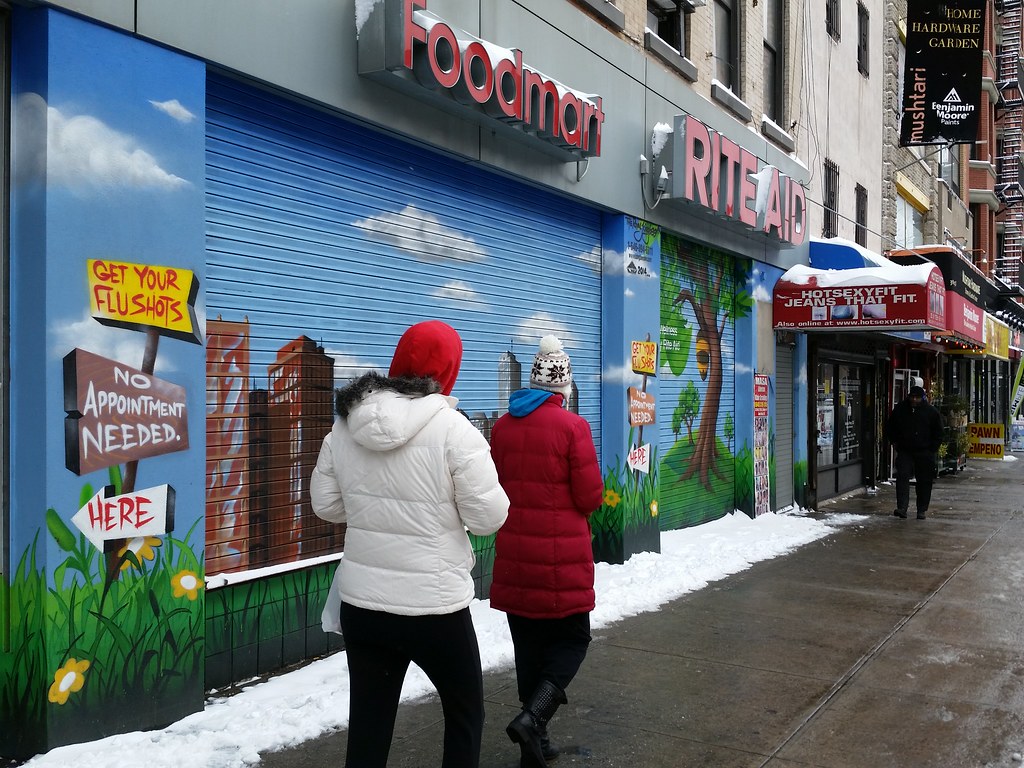
At this point, it's an established fact that the Royal Kingbee's territory has expanded well beyond the borders of the Bronx in the last couple of years, largely onto the walls of Rite Aids in Manhattan and Brooklyn. (He also established an early outpost at an East Village hair salon at least as far back as May 2009.) Here we have even more evidence of his growing pharmaceutical empire.

Faded tushies sharing space with the Rite Aid. Check out the video on their website for an insightful meditation on humanity's eternal question: "How does my butt look?"
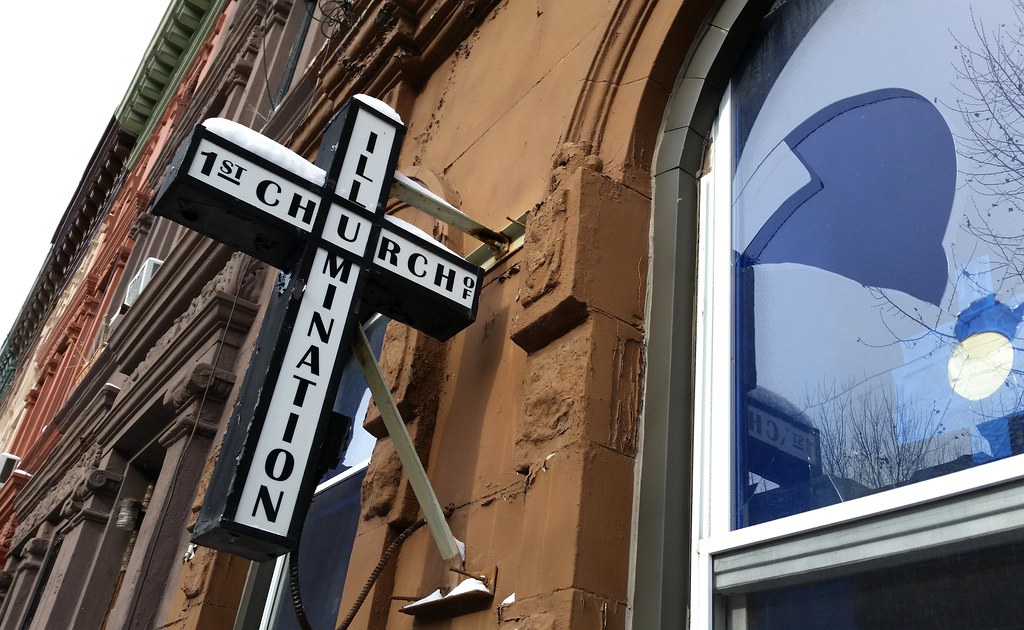
The First Church of Illumination "began in 1922 as a chapel for the Rosicrucians".
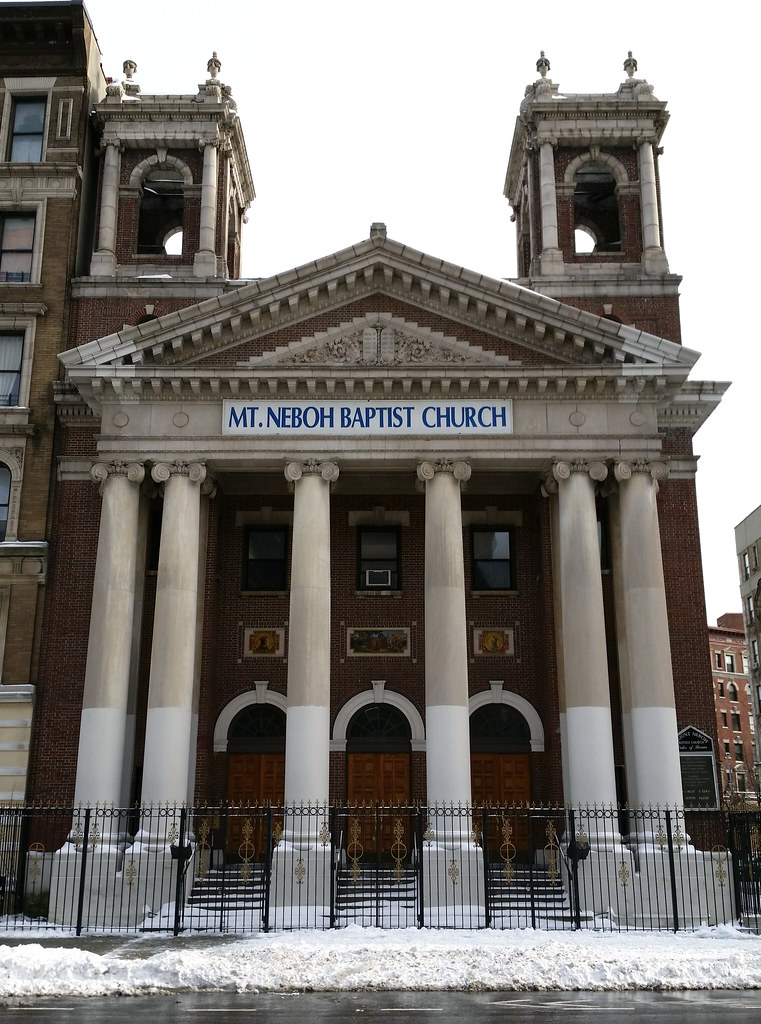
Mount Neboh Baptist Church, formerly the Roman Catholic Church of Our Lady of the Miraculous Medal and originally the synagogue of Congregation Ansche Chesed, is perhaps the only house of worship in the city to have served as a full-time home to Jews, Catholics, and Protestants.
(I would argue that the other church mentioned here as having served all three faiths, St. Ann's Armenian Catholic Cathedral, doesn't really count. For one thing, it no longer exists: its sanctuary was demolished in 2005, leaving only the facade standing. But even before that, the original sanctuary used by the Protestants and the Jews was itself demolished and replaced with a new one by the Catholics, so the three faiths never actually worshiped under the same roof.)
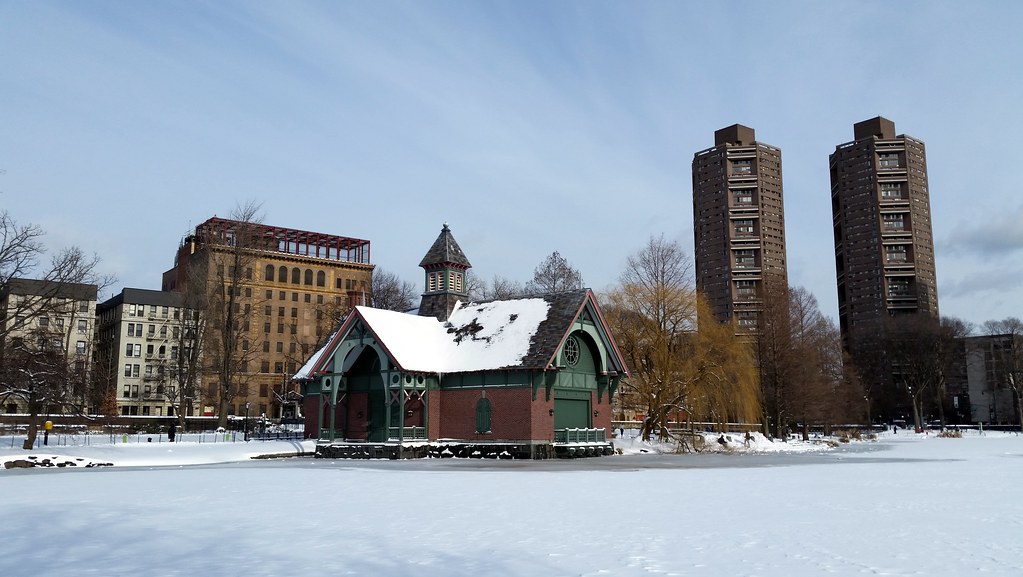
At center is the Charles A. Dana Discovery Center, Central Park's newest building, completed in 1993 here on the shore of the Harlem Meer. To its left is the Lincoln Correctional Facility and to its right are the twin towers of Schomburg Plaza.
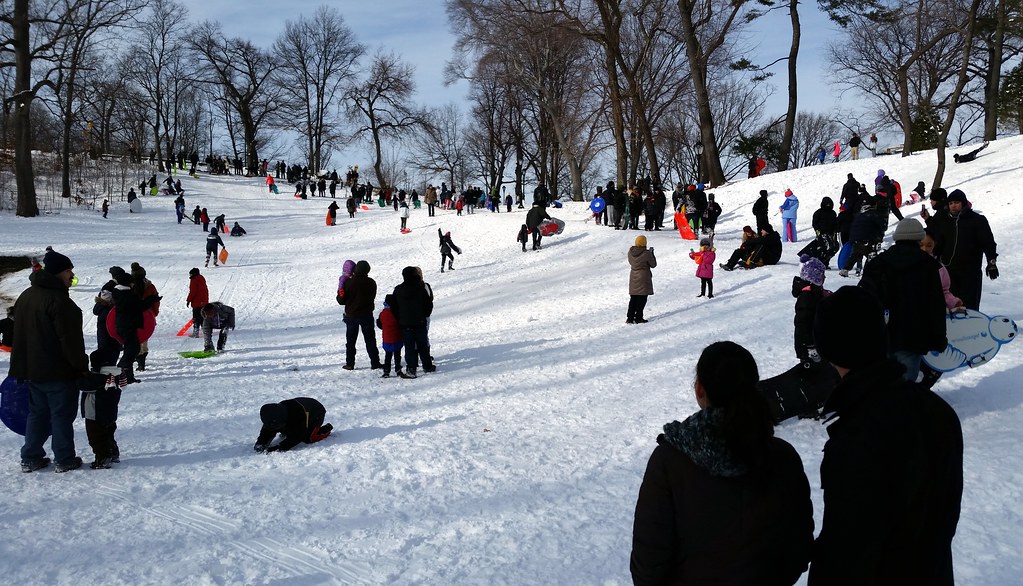
Thanks to the predicted apocalyptic wrath of Winter Storm Juno, schools were closed today and many people stayed home from work. When the storm turned out to be far less severe than expected, there were suddenly a lot of people with some rare weekday free time looking to take advantage of the season's first substantial snowfall. A sizable contingent of them flocked, sled in hand, to this spot in Central Park, just northwest of the Conservatory Garden. In addition to the crowd you see in the background of this shot, there were also groups gathered out of frame to the left and right, and kids were chaotically bombing downhill from all three directions, often inadvertently colliding in the center at surprisingly high speeds. No one seemed to mind getting clobbered though; I guess everyone was bundled up in enough layers to absorb most of the impact.

Named after Central Park's co-designer Frederick Law Olmsted (closer look), this minimalist sled is the ninth annual snow buggy created by this guy and his friends.

This is a tribute to Derek M. Armstead, a.k.a. Bloodshed, a local Harlem rapper who died in a car accident (driving the BMW pictured above) in 1997. Bloodshed performed in a group called Children of the Corn alongside his cousin Cam'ron (whom we've previously seen in the Clipse video featuring the former Obama Fried Chicken restaurant in East Flatbush/Brownsville), Ma$e, Big L, and McGruff. The lyrics on the left side of the mural, Bloodshed's contribution to a Children of the Corn song entitled American Dream (audio, lyrics), seem to have been excised of some objectionable content (close-up).
Note also the (presumably) stolen shopping cart locked to the bike rack.
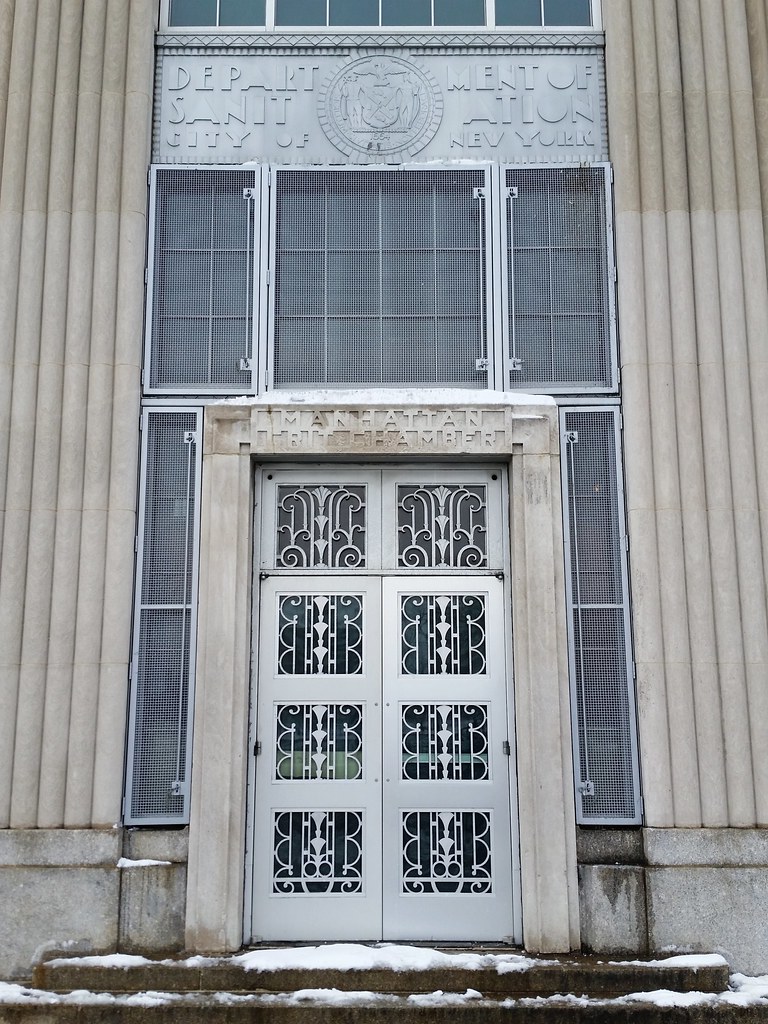
This is the Manhattan Grit Chamber (whose Hurricane Sandy high-water mark we saw on a previous visit), sibling of the Bronx Grit Chamber. From the NY Times:
The best places to see the celebrated products of New York — its Broadway talent, its skyscraper architecture — are well known.A guy who works here was standing outside when I walked by. He told me nothing too crazy has washed in lately, other than the 50 bucks he found not long ago.
But the best place to see Manhattan's byproducts — what is stuffed down its sinks, flushed down its toilets and washed from its gutters — cannot be found in tour guides. There is perhaps no better vantage point than the Manhattan Grit Chamber, which strains solids from much of the borough's sewage as it flows underground to the Wards Island Wastewater Treatment Plant. . . .
"We get a lot of turtles and fish. . . . We've had a canoe come in here; it got caught on the screen. We've had pieces of telephone poles, Christmas trees. Oh, you name it — mattresses, dead dogs. We got a live dog once."

The wide block of 109th Street between 2nd and 3rd Avenues serves as the playing field for the East Harlem Stickball League. In 2005, the block was named in honor of the Stickball Hall of Fame, which has since found a permanent home on 123rd Street. This is now the second street we've seen named after stickball; the first was Stickball Boulevard in the Bronx.
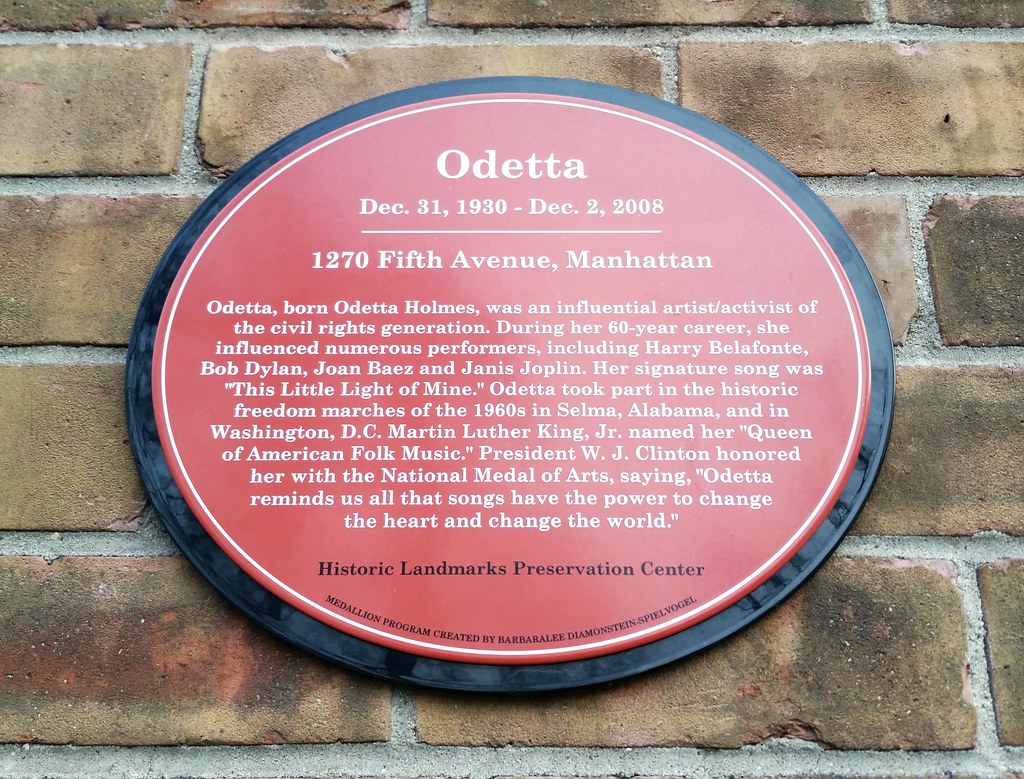
This building was the longtime home of Odetta, "the singer whose resonant voice wove together the strongest songs of American folk music and the civil rights movement", according to the NY Times.
Bob Dylan: "The first thing that turned me on to folk singing was Odetta. I heard a record of hers in a record store, back when you could listen to records right there in the store. That was in '58 or something like that. Right then and there, I went out and traded my electric guitar and amplifier for an acoustical guitar, a flat-top Gibson."
Maya Angelou: "If only one could be sure that every 50 years a voice and a soul like Odetta's would come along, the centuries would pass so quickly and painlessly we would hardly recognize time."
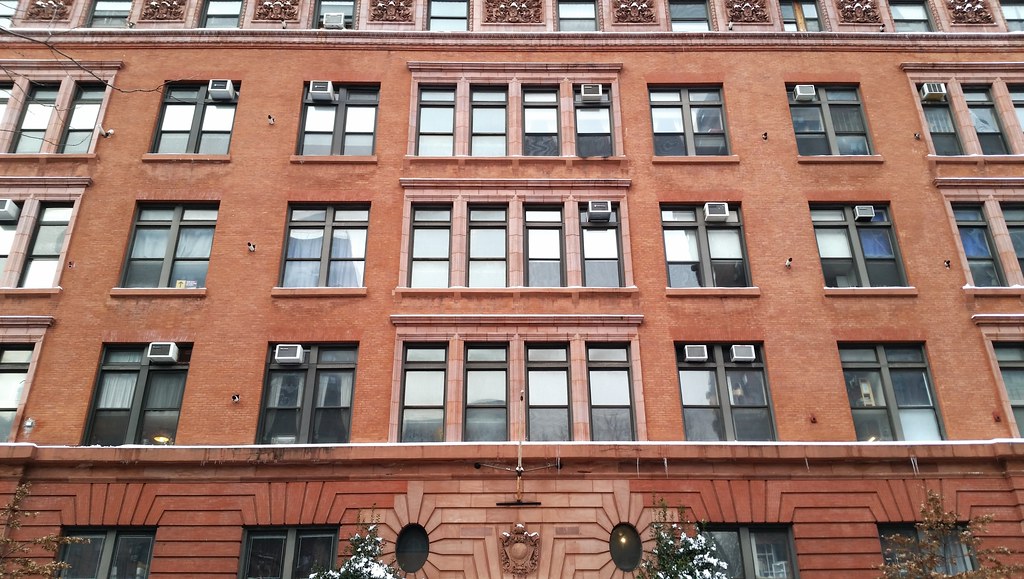
This former public school was converted into loft condominiums (photos) around 1986 and is also home to the Poet's Den Gallery and the Poet's Den Theater.
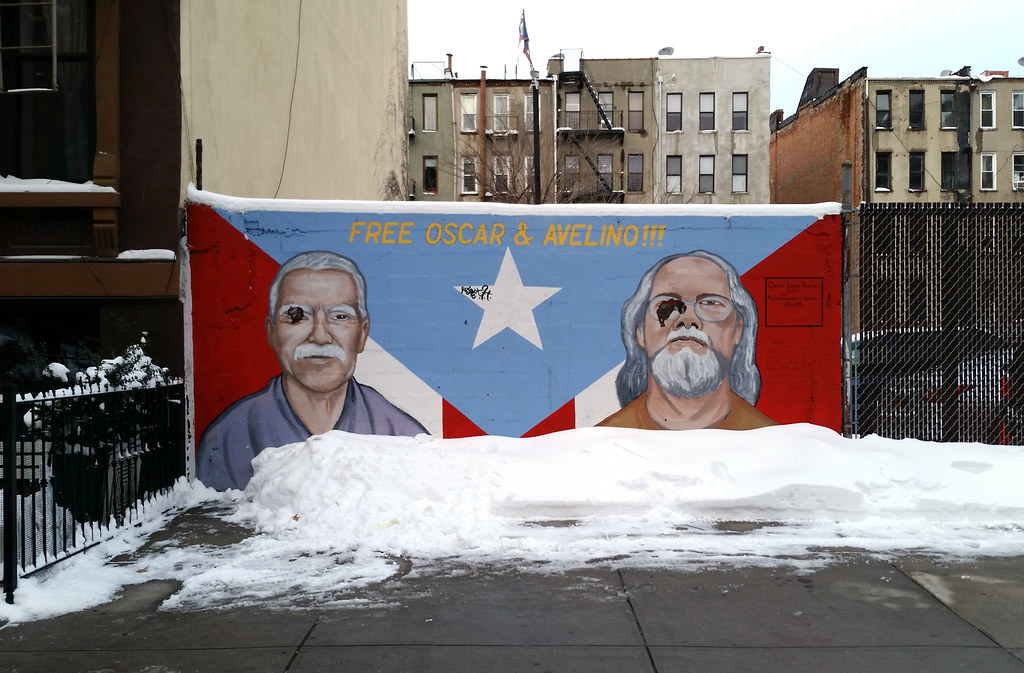
Avelino has been freed since this mural was painted in 2010, but Oscar has not.
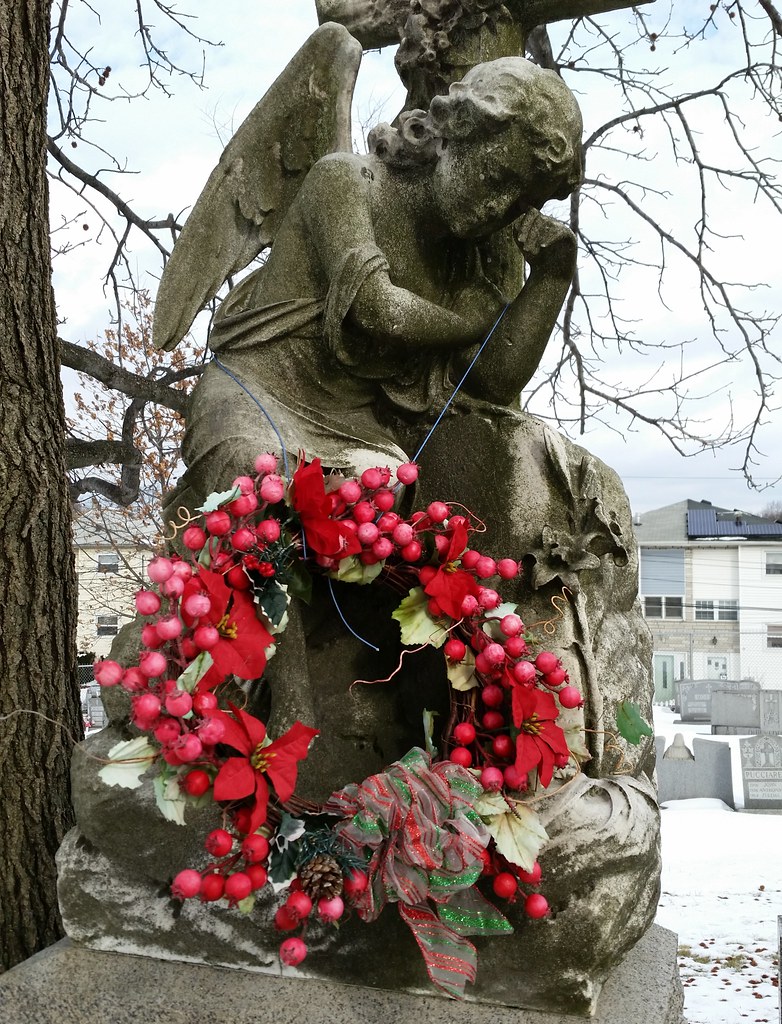
at St. Mary's Cemetery (and a rooftop solar array in the background)

